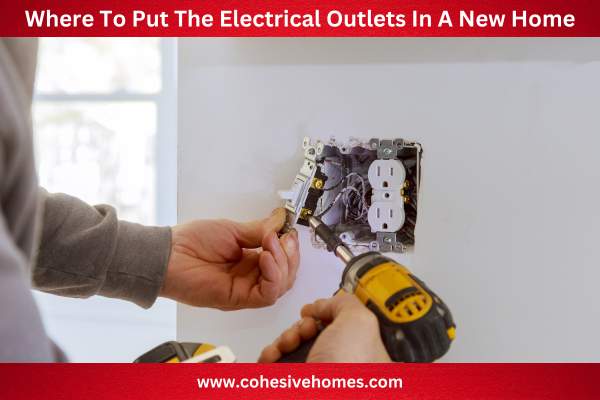Have you ever experienced the frustration of not having enough electrical outlets in your home?
Or you’ve faced the dilemma of not knowing where to place them in a new home.
Electrical outlets are a crucial aspect of any modern home, allowing us to power our devices and appliances.
However, their placement should be considered during the design stage, to avoid inconvenience and potential safety hazards.
This blog post will discuss where to put electrical outlets in a new home to ensure maximum convenience, safety, and functionality.
When building a new home, it’s essential to consider where to place electrical outlets.
Ensuring there are enough outlets in every room is crucial to avoid relying on power bars or extension cords.
The kitchen should have outlets on countertops and around the kitchen island to accommodate the various small and large appliances.
For the family room or bar, you may need additional outlets to run small refrigerators, blenders, or to power a lighted bar sign. The living room should have plenty of electric outlets for convenience in every corner of the sitting room.
The bathroom needs plugs for blow dryers, electric toothbrushes, and shavers.
Follow these guidelines to ensure your house is well-wired for convenience.
Where To Put The Electrical Outlets In A New Home

When building a new home, planning for electrical outlets is important.
You want to avoid moving in and realizing you have insufficient outlets or that they do not fit well with your furniture plan.
Consult with a licensed electrician to ensure the outlets comply with building codes.
Following are some common places where you need to install electrical outlets:
Floor Outlets for Study Spaces and Lamps
Floor outlets are a great option for study spaces and lamps.
They allow for flexibility in furniture placement and prevent cords from being tripping hazards.
Placing floor outlets near study spaces is especially useful for those who need a lot of electronic equipment, such as computers and monitors.
Additionally, floor outlets near lamps provide a seamless look and eliminate the need for cords running across the floor.
Bedrooms Outlets

When adding outlets in the bedroom, the rule of thumb is to have at least one on each side of the bed.
This is ideal for lamps and charging phones.
Adding outlets on every wall is a good idea for larger bedrooms, as it provides convenience for digital devices, vacuum cleaners, and fans.
Considering furniture placement and how it affects the need for outlets is important.
Entryway Outlets

The entryway is the first thing guests see when they come to your house, and it’s important to have electrical outlets available in this area.
Installing outlets near the front door allows you to plug in a welcome sign or holiday decorations to greet visitors. Charging stations for phones and other electronic devices are also a must-have in the entryway.
It’s a good idea to have at least one outlet on each side of the entryway so you can easily plug in a vacuum or other cleaning equipment.
Garage Outlets

The garage is often overlooked when planning the electrical outlets in a new home.
Considering the need for power tools, pressure washers, and vacuum cleaners in this area is important.
At least one outlet on each side of the garage is recommended.
Having an outlet inside the garage for a workshop area is also helpful.
Additionally, an outlet in the garage can be used for charging electric cars or as a convenient spot for plugging in outdoor landscaping equipment.
Home Office Outlets

When setting up a home office, it’s important to consider the placement of electrical outlets.
It’s recommended to have multiple outlets installed slightly above desk height for convenience.
This allows easy access to plug-in electronic devices such as monitors, phones, computers, and printers.
It’s also important to determine a suitable location for lighting and install an outlet for it.
With more people working from home than ever before, having a well-wired home office can provide convenience and efficiency, ensuring that all electronic devices can be powered without the need for unsightly and potentially hazardous extension cords or power bars.
Kitchen Outlets

When planning where to put electrical outlets in a new home, it’s essential to notice the kitchen area.
The kitchen contains numerous large and small appliances that require electricity to operate properly.
Installing outlets in multiple locations throughout the kitchen is recommended, including on countertops and around the kitchen island.
Additionally, it’s important to consider your cooking needs, the number of devices you need to run simultaneously, and where you plan to hang lights or install security cameras.
Outlets on countertop surfaces should have GFCI protection. Finally, if you have a walk-in pantry, installing an outlet to charge cordless vacuums or dustbusters is a good idea.
Living Room Outlets
In the living room, it’s important to have plenty of electrical outlets in all corners of the space.
Consider adding additional outlets in the middle of each wall, particularly if your end tables are in the center of the room.
If you plan on hanging a TV on the wall, make sure to install an outlet behind the screen to keep cords tucked away.
For those who decorate during the holidays, decide where your Christmas tree will go and place an outlet accordingly. Additionally, if you use table lamps, consider installing outlets on the floor to power them.
Remember your family’s digital devices – having ample outlets to charge phones and tablets is a must.
Bathrooms Outlets

In terms of safety, GFCI outlets are a must-have in the bathroom.
Outlets should be placed near each sink, but ensure that cords do not cross over the sink and are at least one foot away.
To maximize functionality, consider installing outlets inside medicine cabinets and drawers to charge electric toothbrushes, hair tools, and razors out of sight.
It is important to keep outlets at least 3 feet horizontally and 8 feet vertically away from the shower and bathtub areas.
Also, make sure to follow the NEC and ensure that all bathroom outlets are GFCI protected to prevent electrical shocks.
Family Room Outlets
The room is a hub of activities and entertainment.
Therefore, having enough electrical outlets to accommodate all your devices and gadgets is important.
Install outlets on every wall, specifically behind your couch and chairs.
Add extra outlets close to your entertainment center to power your TV, cable box, gaming console, and sound system.
If you have a home bar, add some outlets to power your blender and small refrigerator.
If you prefer a fireplace, add extra outlets for a lighted sculpture or wall clock.
Outdoor Outlets

Outdoor outlets are a must-have in any home, especially for those who love decorating their property’s exterior.
For example, outlets on the front porch can power holiday lights or welcoming décor.
Outlets on the back porch or deck are ideal for grills or outdoor heaters.
Further, outlets outside the garage can be used for washing and cleaning cars.
It’s important to note that outdoor outlets should always have a cover to protect them from the elements.
A professional electrician can ensure that these outlets are up to code and safe to use. With strategic placement, outdoor outlets can provide added functionality and endless possibilities for outdoor living and entertaining.
Who You Should Contact When Planning On Installing Electrical Outlets For Your New Home
When planning on installing electrical outlets in your new home, it’s important to contact a licensed electrician to ensure that your installation is up to code and that your home is safe from electrical hazards.
They will be able to guide you on the best placement of your outlets based on your home’s use and needs.
Keep in mind that specific requirements need to be met based on the National Electrical Code (NEC), such as placing outlets every 6 feet along the floor line in areas designated as living spaces.
In addition, electricians can help you with creative ideas on where to place outlets, such as in the pantry for small appliances or in the back of drawers for charging hair tools and electric razors out of sight.
Contacting a professional will give you the peace of mind you need to have a properly installed and functional electrical system in your new home.
Which Are The Places You Must Refrain From Installing Electrical Outlets

When installing electrical outlets in a new home, there are a few places where you must refrain from doing so.
1. These outlets should never be placed near water sources, such as sinks or showers, as electricity and water simply do not mix.
2. Placing outlets too close to heating and cooling vents can also be problematic, as it can cause electrical fires.
3. Certain areas in your home, such as attics and crawl spaces, also require special consideration when it comes to outlet placement.
3. Avoid placing outlets in areas where they will be exposed to potential damage, such as under furniture or in high-traffic areas.
It is best to hire a home inspector to find any potential issues in your new home’s electrical outlet or any other area.
A home inspection can cost between $350 and $600.
Conclusion
In conclusion, the placement of electrical outlets is a crucial aspect of building a new home.
By actively participating in the planning stages, homeowners can ensure that their houses are well-wired for convenience and efficiency.
Vital areas for installing electrical outlets include the kitchen, family room or bar, living room, bedrooms, bathrooms, home office, and outdoor areas.
Electrical outlets should be installed in spots that give people reasonable access to them in any room while also considering spacing requirements and local regulations to prevent hazards.
Remember to consult national codes for wiring in residential and commercial homes to ensure the ideal outlet spacing and quality of products.
In all areas of the home, be creative with outlet placement to avoid messy cords and reduce cord clutter.
FAQs
How Many Sockets Can You Install In The Kitchen?
The number of sockets required for a kitchen depends on the size and layout of your kitchen, as well as your electrical needs.
You will need enough sockets to power appliances and any other devices you may use in your kitchen, such as electric mixers or blenders.
Make sure to include GFCI protection for any sockets on your countertops or near water sources to prevent electric shock.
Do I Need To Install Electrical Outlets On Every Wall?
Installing electrical outlets on every wall is unnecessary, but it is recommended to have outlets placed every 6 feet throughout the house.
The placement of outlets should be based on the specific needs and usage of each room.
What Is The Height Of Garage Outlets?
According to the National Electric Code (NEC), there are no specific height requirements for garage outlets.
Most people install their outlets between 12 and 18 inches above the floor, in accordance with common practice.
However, the height of the outlets can be adjusted based on the intended use of the garage.
